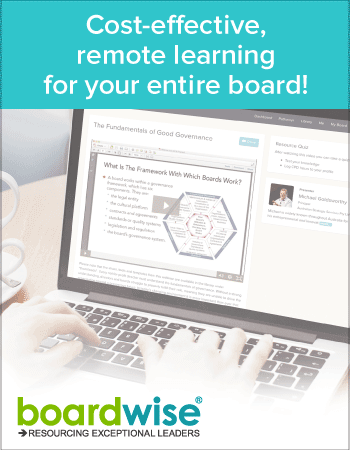book-review
Directors at Work: A Practical Guide for Boards
Published: May 13, 2013
Read Time: 4 minutes

Directors at Work: A Practical Guide for Boards by Geoffrey Kiel, Gavin Nicholson, Jennifer Ann Tunny and James Beck is a substantive reference manual for all types of board directors.
Directors at Work is a generous text, both in size and in breadth of content. The 818-page book addresses a huge range of issues applicable to directors and offers a practical approach to each.
Directors at Work is not the type of book you should attempt to read over a weekend (as I did), nor is it something you should scramble to speed read before your first board meeting. This book contains far too much information to be rapidly digestible; instead, it is the kind of book that necessitates a little quiet contemplation and inspires readers to perhaps undertake further discussion or research on a particular question or suggestion that it raises.
The authors of Directors at Work are researchers, practitioners and consultants in governance and, combined, have an extensive record of expertise in this area. Gavin Nicholson and James Beck, in particular, have a long history of working in the non-profit sector and are well-respected authorities on non-profit governance. This book is a kind of second edition of the well-regarded earlier title Boards that Work: A New Guide for Directors (2002) written by Geoffrey Kiel and Gavin Nicholson.
Although this book is not aimed specifically at non-profit directors, it remains largely applicable to the sector. Unlike many other similar texts it does not relegate non-profit governance to a single chapter in its closing pages. Non-profit governance is not an afterthought to the authors, but an equally legitimate and important aspect of governance. They have raised non-profit governance to the same level as corporate governance and assume that non-profit directors are and should be equally as capable and experienced as their corporate counterparts. Kiel et al propose that non-profit boards require similar information and instruction and that their work is of comparable importance. The introductory paragraph of each chapter effectively frames the issues to be addressed in the following pages within the context of the board’s work and the authors have taken pains in many chapters to acknowledge and address how each issue is also of relevance to non-profit boards.
Directors at Work is exhaustively well researched. It provides readers with access to a broader undercurrent of academic thinking about governance practices and the roles and responsibilities involved. Kiel et al do not talk down to readers; the tone of the book is quite formal but it speaks with authority. They have assumed that their readers, likely to principally be current and prospective board members, are intelligent people and readily able to grasp difficult concepts. The book is academic but not overly dry or distant. It is academic in a manner that inspires confidence and reassures that all assertions and advice are supported by evidence and represent current academic practices and thinking.
Directors at Work may be a very hefty text but it is carefully structured in a way that makes the book accessible to a brief perusal in order to seek advice on a particular issue. The first chapter, largely a sort of preface to the book, introduces the authors’ corporate governance practice framework and charter. It ends with a checklist that outlines the contents of the following chapters and is designed to guide the reader through the book. The remaining chapters each address a specific aspect of the board’s role or serve a particular purpose. The authors offer multiple solutions and tactics for addressing each challenge or opportunity raised in the book and the book is healthily peppered with diagrams, tables and checklists designed to aid practical application.
Directors at Work is not a book for novices. It is a serious work of high-level advice and information aimed at readers wishing to interact with governance practices and thinking at an advanced level.
Published by Thomson Reuters, 2012. 818 pages.
Share this Article
Recommended Reading
Recommended Viewing
Author
-
Former Researcher
Better Boards
- About
-
At the time of writing Julia was a writer and researcher at Better Boards. She has a passionate interest in the non-profit sector, particularly its legal and regulatory complexities and she follows all news and developments in this area keenly. Prior to joining Better Boards, Julia served as an intern at Philanthropy Australia. Julia has a Bachelor of Arts from the University of Melbourne, majoring in Political Science and English Literature.
Found this article useful or informative?
Join 5,000+ not-for-profit & for-purpose directors receiving the latest insights on governance and leadership.
Receive a free e-book on improving your board decisions when you subscribe.
Unsubscribe anytime. We care about your privacy - read our Privacy Policy .







